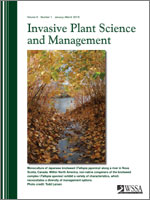The European vines pale swallowwort and black swallowwort are invading various habitats in northeastern North America. It is unclear how these plants might respond to potential biological control agents, as they experience little herbivore damage in North America, or longer durations of mowing given the reported lack of efficacy of mechanical control. We evaluated the effect of six seasons of artificial defoliation (50 or 100% defoliation once or twice per season) and clipping (once, twice, or four times at 8 cm above the soil level) on the survival, growth, and reproduction of mature plants of the two species grown in a common garden field experiment. No plants died from damage after 6 yr. Black swallowwort produced more aboveground biomass, whereas pale swallowwort produced more root biomass and root crown buds, compared with its congener species. For most damage treatments, root biomass and the number of crown buds and stems increased over time, whereas aboveground biomass and viable seeds per plant generally did not change. Substantial overlap in plant size and seed production occurred among damage treatments and species. The most severe defoliation treatment did not substantially limit growth and reproduction compared with undamaged plants. While two clippings per season sometimes prevented seed production, four clippings per season was the only type of damage that consistently prevented plant growth and eliminated seed production. Pale and black swallowwort display a high tolerance to aboveground tissue loss in high-light environments without plant competition. The annual increase in plant size calls into question the potential efficacy of a defoliating insect against field populations of swallowworts, and it seems likely the only benefits of a long-term mowing regime will be to eliminate seed production.
Nomenclature: Black (or Louise's) swallowwort, Vincetoxicum nigrum (L.) Moench, syn. Cynanchum louiseae Kartesz & Gandhi; pale (or European) swallowwort; Vincetoxicum rossicum (Kleopow) Barbarich, syn. Cynanchum rossicum (Kleopow) Borhidi.
Management Implications: Pale swallowwort and black swallowwort are European viney milkweeds that have become invasive in eastern North America since the 1980s. Mechanical control is considered ineffective, but previous studies have only been conducted for 1 or 2 yr. Biological control is also being developed, but it is unclear how these plants might respond to damage such as defoliation over a period of years. We evaluated different artificial defoliation and cutting treatments over 6 yr in a common garden field experiment in Ithaca, NY, for their effect on swallowwort survival, growth, and reproduction. Black swallowwort produced more aboveground biomass, whereas pale swallowwort produced more root biomass and root crown buds, compared with the other species. However, they appeared to respond similarly to damage. No plants died after 6 yr of the different damage treatments, and in general, they increased in size (root biomass, number of crown buds and stems) or did not change (aboveground biomass, seeds per plant) over time. The most severe defoliation treatment (100% twice each year) did not substantially limit growth and reproduction compared with undamaged plants. This result calls into question the potential efficacy of a defoliating insect against field populations of swallowworts. Two clippings per season sometimes prevented seed production and should be considered the minimum frequency of mowing for this purpose. Four clippings per season was the only type of damage that consistently prevented plant growth and eliminated seed production, although it is not clear what the long-term effects of high-frequency mowing will be apart from eliminating seeds. Pale and black swallowwort display a high tolerance to aboveground tissue loss in high-light environments without pl






